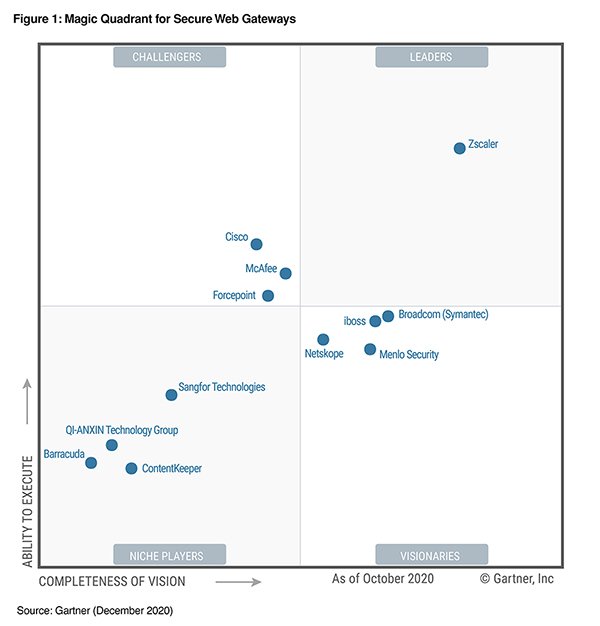I am thrilled about the massive milestone Zscaler has achieved this week with the 2020 Gartner Magic Quadrant for Secure Web Gateways.

It is an achievement every entrepreneur dreams of. It starts with the moment when you realize a fundamental change is about to reshape the world. And as entrepreneurs and visionaries, you tie that to a shift in the very basis of how certain capabilities were built or necessitated.
It is a long road from there...from realization to implementation, and then an even longer road of execution to show and gain the confidence of the marketplace. Ten years in, it is amazing to see how well the Gartner Magic Quadrant demonstrates that journey.
Our first year in the Magic Quadrant was 2011—the market was saturated with numerous vendors, with five in the Leaders quadrant alone. SWG was largely URL filtering and antivirus. However, everyone knew that as internet usage increased, SWG would have to expand to become the DMZ of choice for most organizations. However, all this was expected to be done on appliances in a host of shapes and sizes.
Peter Firstbrook and Lawrence Orans had realized that the future was cloud, but it was only a visionary idea. I remember flying with Jay to meet Peter in a small frozen town in Canada to whiteboard ideas for an advisory day. The many conversations with Lawrence over the future of networking in Connecticut. At the time, the Magic Quadrant questionnaire had fewer than five questions (out of 100+) that asked about a cloud form factor.
Propelled by Jay’s extraordinary vision and conviction, Zscaler entered that world with a bold, one-of-a-kind born-in-the-cloud product portfolio that rivaled the best appliances. In the very first year, Zscaler secured a position in the Magic Quadrant as the furthest right on the visionary axis—a position Zscaler has proudly continued to own ever since.
A new entrant can never beat legacy vendors for revenue or execution on day one. But a new entrant wins a market only if they have better vision and conviction of the future than everyone else. Otherwise, it is only a “me too.”
Over the numerous years, our conviction was tested many times. For a company that was started in one of the worst recessions in the U.S., the journey was definitely not a cakewalk.
As cloud, Microsoft Office 365, and mobility caught on, the need for a cloud form factor to protect employees became obvious. At the same time, the growth of SaaS, IaaS, and PaaS made it critical for the SWG to become the focal point of network protection. Clear trends like SSL everywhere meant the only relevant point for network protection is the proxy that can inspect all SSL traffic. This resulted in the SWG definition subsuming or adding many previously independent functions (with the Magic Quadrant questionnaire reflecting this change):
- Coverage for all ports and protocols (Cloud Firewall)
- Advanced malware detection with IPS, sandboxing, machine learning, and more
- Data loss prevention and CASB
- Coverage for handheld form factors (Android and iOS)
- Remote browser isolation technologies
- Zero trust
As the market adopted this change, the Magic Quadrant has clearly reflected vendors that kept up and were recognized not only by Gartner for vision, but also by the market at large for execution. Through our early years, industry visionaries, including Larry Biagini at GE, saw the need for a new way to ensure the security of their massive organizations. The same realization was happening all over the world across organizations in every vertical. These early customers shaped the outcome of what the SWG needed to become.
Each year as SWG became more complex and the importance of the cloud grew, the old leaders started to fall away. Each year, Gartner continued to push clear guidance of cloud being the future. To a point two years ago when the Magic Quadrant questionnaire had 90 percent of its questions focused on the cloud form factor. What a shift, and kudos to Gartner analysts for keeping their ears to the ground and staying one step ahead to guide the market.
This year’s pandemic brought the changes Gartner has been espousing into sharp focus. Enterprises that had adopted new approaches—cloud-delivered security, zero trust, CASB, digital experience monitoring—were positioned to quickly enable their employees to work securely and remotely. Those companies that were relying on legacy technologies faced an uphill battle to scale for a fully remote workforce (on unmanaged devices), provide secure access to private apps, and protect data.
It is with great pride that we see the Magic Quadrant released this week demonstrating Zscaler’s conviction and hard work paying off. We are the only Leader in the most important security product family that is subsuming all of the past network-based defenses.
While we wholeheartedly embrace our role in creating innovative, “disruptive” technology, we’ve always measured our success by that of our customers, who have been keeping the world working, literally. They’re running multinational corporations with their employees safely at home. They’re running financial institutions, government agencies, healthcare systems, energy infrastructure, and much more. We’re immensely proud to serve thousands of organizations around the world and that they trust us to help them meet the challenges of the day while keeping their lifeblood—people, systems, and data—accessible and secure.
Customer obsession is a core value at Zscaler, and while we will all spend a moment reveling in the 2020 Gartner Magic Quadrant, we will quickly get back to our work of empowering customers to transform securely to the digital future—no matter what it may bring. That’s the real prize.
Please read the blog by Jay Chaudhry in which he responds to 10 years of Gartner Magic Quadrant leadership and this year’s position as the only Leader. And be sure to download your free copy of the Gartner report.






